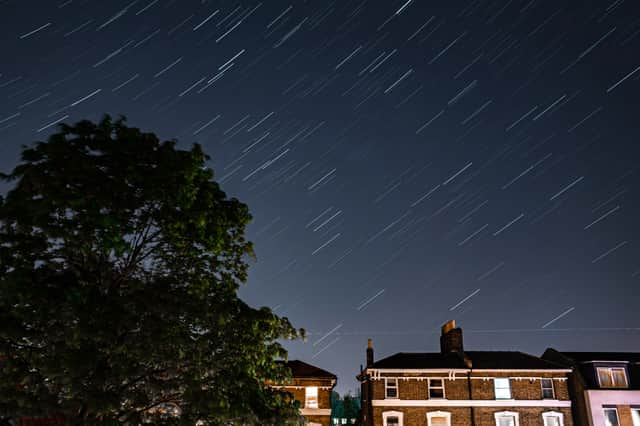Lyrid meteor shower UK: 2024 peak date, how to see it, what is it, do you need binoculars - weather forecast


Prepare to observe a time-honoured and breathtaking cosmic phenomena this weekend: the Lyrid meteor shower.
As Earth traverses the remnants of Comet Thatcher's path, enthusiasts are in for a treat, with the potential for up to 18 meteors per hour illuminating the early morning heavens.
Advertisement
Hide AdAdvertisement
Hide AdThe spectacle will reach its climax during the small hours of Monday 22 April, and you can expect to see bright, fast meteors, with some leaving dazzling trails - or ‘trains’ - behind them.
Has this spiked your curiosity about the meteor shower? Wondering when and how to catch the best views, and eager for tips to maximise your meteor-spotting experience? Look no further – here's your complete guide to everything you need to know about the event.
What is the Lyrid meteor shower?
The Lyrid meteor shower is an annual meteor shower that occurs in mid-to-late April. It is named after the constellation Lyra, from which the meteors appear to radiate.
It is one of the oldest known meteor showers, with records of its observations dating back more than 2,700 years, and was first recorded in China in 687 BC.
Advertisement
Hide AdAdvertisement
Hide AdIt has been observed by astronomers and skywatchers ever since, and has become known for producing bright and fast meteors, with some meteors leaving persistent trains, which are glowing trails that last for a few seconds after the meteor has passed.
During the peak of the Lyrid meteor shower, which typically occurs around 22 April, observers can expect to see around 10 to 20 meteors per hour.
However, the number of meteors visible can vary from year to year; in some years, the Lyrid meteor shower can produce up to 100 meteors per hour, while in other years the number of meteors visible may be much lower.
The Lyrid meteor shower is caused by the Earth passing through the debris left behind by the comet C/1861 G1 Thatcher, which orbits the sun once every 415 years.
Advertisement
Hide AdAdvertisement
Hide AdWhen the debris enters the Earth’s atmosphere, it heats up and creates the streaks of light known as meteors. The comet was last seen in 1861, and is not expected to return to the inner solar system until around the year 2276.
How to see it
The Lyrid meteor shower can be observed with the naked eye, and the best time to observe it is after midnight and before dawn when the constellation Lyra is high in the sky.
You’ll want to find a dark location from which to get the best views of the shower, as the darker the location, the better the viewing experience will be.
Advertisement
Hide AdAdvertisement
Hide AdYou’ll likely still be able to see some of the brighter meteors from wherever you are, but finding a spot away from city lights and light pollution will increase your chances of seeing even more.
Once you’re in your chosen viewing spot, give your eyes time to adjust to the dark. You might think this would only take around a few minutes, but it can take about 20 minutes for your eyes to properly adjust to low light levels, so be patient.
Of course, April nights aren’t usually the most temperate, especially in the UK, so if you’re planning to spend an extended amount of time outside, bring something comfortable to sit on.
Observing the meteor shower can take some time, so make sure to bring something comfortable to sit on, and check the weather forecast and dress appropriately for the conditions.
Advertisement
Hide AdAdvertisement
Hide AdAt the time of writing, the Met Office is forecasting it to be “perhaps cloudier across some northern and eastern areas” on the night of the peak, “where the odd spot of rain or shower is possible.”
While the meteors will be visible in almost every section of the night sky, they will appear to radiate from the constellation Lyra, so look towards that direction in the sky.
It may also be tempting to whip out a pair of binoculars to get a closer view of the meteors, but these will actually narrow your field of view, making it even harder to spot the shooting stars as they whizz across the sky (they’re still useful for observing other celestial objects like the Moon and planets of our Solar System though).
When will it be visible in 2024?
The Lyrid meteor shower can be seen every year in mid-to-late April.
In 2023, it is expected to be visible in the northern hemisphere from Monday 15 April to Monday 29 April with the peak predicted to occur in the early hours of Monday 22 April.
Comment Guidelines
National World encourages reader discussion on our stories. User feedback, insights and back-and-forth exchanges add a rich layer of context to reporting. Please review our Community Guidelines before commenting.
